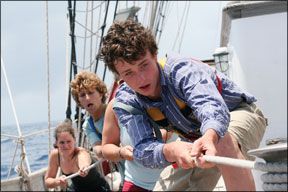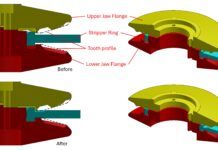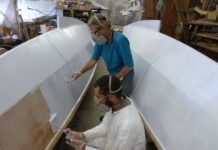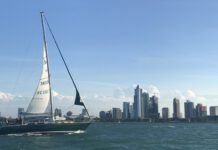
Photos courtesy of Sea Education AssociationPhoto courtesy of Mark AndersonPhoto courtesy of Lee OppegaardPhoto courtesy of Steve GillPhoto courtesy of Quickline USA
288
Thank you for extending the offer to sailing nonprofits to tell their stories. The Sea Education Association (SEA) has been teaching college undergraduates about the ocean for the last 40 years. We offer several different SEA Semesters, which combine six weeks of classroom study in Woods Hole, Mass., with a six-week open ocean voyage on one of our two sailing research vessels. College students earn credit for their study of oceanography, maritime history, literature, marine policy, and nautical science.
SEA is the only semester-abroad program that actually gets students out on the open ocean. Our 7,000 alumni have sailed over a million miles, learning the physics, chemistry, geology, and biology of the ocean while sailing the Northwest Atlantic, Caribbean, and Pacific oceans.
Our vessels are 135-foot brigantines sailed and navigated with 19th-
century methods while the students conduct science in state-of-the-art labs. As the students learn about the ocean, they also learn about themselves in ways that can only happen at sea on a tallship. Our students come from all colleges and all majors. Our alumni can be found in ocean research institutions, universities, government agencies, environmental groups, sail-training organizations, and many other professions. In the summer, we run a condensed program for high-school students wanting the same kind of challenging hands-on experience. For more information, go to www.sea.edu.
John K. Bullard
President, Sea Education Association
Woods Hole, Mass.
A sailing nonprofit that is a truly amazing program: The Nova Scotia Sea School operates out of Lunenburg, Nova Scotia, taking teenagers and adults on coastal sailing adventures in traditional wooden boats built by students. To find out more visit www.seaschool.org.
Crane Stookey
Via e-mail
I’d like it if you wrote an article on wind generators with the following information: 1) Factors to consider before buying a wind generator; 2) Factors to consider when installing a wind generator (controls, wiring, placement, etc.); 3) What to consider when selecting a generator (performance, reliability, sound, etc.).
Sabin Peterson
Maikai, Southern Cross 31
Via e-mail
A comprehensive wind generator buyers guide is a good idea, one we will follow up on for sure. In the meantime, you may find some past wind-gen reviews and articles to be helpful. “Choosing a Wind Generator” (June 2007) looks at wind-gen features like blade size, number of blades, output considerations, and installation factors, and the July 2007 issue reports the performance test results for the five wind generators we tested from Ampair, KISS, Rutland, Southwest Wind Power, and Superwind.
What kind of shorepower will we need to run the “1,000 megawatt” Wi-Fi antenna you wrote about in the November 2010 issue? And what kind of RF shielding will my crew need? Really got a chuckle out of that! Thanks for another great issue.
Jim Mccutcheon
Wild Angel, San Juan 23
Eastern, N.C.
Practical Sailor was deservedly deluged by e-mails prompted by that editing mistake. We hope it will never happen again, but it is nice to know that if it does, it will be received in good humor by our astute and forgiving readers. For more details on building and installing Ed Mini’s homemade, 1,000 MILLIWATT Wi-Fi antenna, check out our blog.
Regarding the pressure cooker review in the December 2010 issue: Pressure cooking is very fast and good for weight watching, but I would suggest that the boat be stationary when using a pressure cooker and that the cooker be tied down. I recommend the electric 7-quart Wolfgang Puck pressure cooker, which is sold on the Home Shopping Network (www.hsn.com).
A few words of advice on using pressure cookers: Release the steam slowly, not half way and then wide open as this may spray steam in someone’s face. (It took me a while to get that right.) Also, when cooking rice, be sure to have enough water and check that the release valve isn’t plugged with food. (Rice and spaghetti will block this area unless checked.) Pressure cookers are great and safe, as long as you go by the directions.
Bill Kerr
30-foot Island Packet
Via e-mail
Thanks for the tips! Look for an update to the December review in an upcoming issue. We’re currently testing a yet-to-be released pressure cooker from Fissler (www.fissler.com).
Thanks for keeping us updated on marine Wi-Fi options (January 2009 and April 2010). An unexpected benefit of being a Sprint customer recently changed my strategy for connecting to the grid while cruising. After upgrading my cell phone to an Android HTC, I was pleasantly surprised to learn that the software includes Sprint Mobile Hot Spot. I can turn the $39/month subscription on and off to match my cruising schedule (down to just a few days of billing) and now have 3G/4G access to the Internet as long as I am within range of a cell tower—that’s a broader coverage area than Wi-Fi.
Turning on the Mobile Hot Spot turns the cell phone into a local router for up to eight devices that can be password controlled. Bandwidth is sufficient to allow large graphic downloads and even video streaming.
Chip Lohman
Whispering Swan
Quantico, Va.
Your networking capabilities appear similar to the ones used by PS contributor Joe Minick and discussed in this issue (January, 2011).
I just downloaded the December 2009 Exterior Wood Finish Exposure Test results. My special interest is in the single-part varnishes comparisons.
I’m doing my own testing on panels of white oak and cedar, which includes a comparison of McCloskey’s Man O War varnish (budget) with Epifanes Clear High Gloss (top quality), over different undercoatings. Unlike your test, I’ve applied the same number of varnish coats. I have started exposing my limited test panels to the weather here in Portland, Ore., and I’m updating the progress monthly online at www.riparia.org/ketch/testpanelsoregon.html.
My impressions so far (the panels have been exposed since Sept. 24, 2010) on the coatings on the white oak: I can tell no differences between the two varnishes. The Cetol finish looks stable. The straight tung oil also seems stable, though it’s a more matte finish. There is no black staining.
On the Port Orford cedar: The tung oil is definitely the best after 2½ months. The linseed oil is showing dry spots. The Thompsons’ Water Seal looks dry; however, water still beads on the TWS area and sheets more on the oil areas.
My plan is to let it go through the winter and then scrub the panels with a Scotch Brite pad and then re-coat.
Mark Anderson
Portland, Ore.

Photos courtesy of Sea Education AssociationPhoto courtesy of Mark AndersonPhoto courtesy of Lee OppegaardPhoto courtesy of Steve GillPhoto courtesy of Quickline USA
288
In regards to the Chandlery review of the Omnia stovetop oven that ran in the August 2010 issue: I used to use an Omnia on my previous boat, which did not have an oven. It worked fine! A definite good addition to any galley without a built-in oven.
Len Lipton
Norwalk, Conn.
Via e-mail
I had tried many cleaners to remove the mildew stains on a vinyl chair aboard my boat, including Spray Nine, and the cleanest I could get it is what you see in the lefthand side of the picture (see photo below). Note the right-side of the cushion is stain free. There, I used calcium-hypochlorite (pool shock) that I bought from a pool supply store for $4 per pound, which will last me virtually forever. I dissolved about a teaspoon of the calcium-hypochlorite into about a pint of water, applied itto the vinyl with a scrub brush, waited until the stains were gone (about 10 minutes), and rinsed with fresh water. It worked great and was easy.
Lee Oppegaard
Wilmington, N.C.

Photos courtesy of Sea Education AssociationPhoto courtesy of Mark AndersonPhoto courtesy of Lee OppegaardPhoto courtesy of Steve GillPhoto courtesy of Quickline USA
288
Once mildew gets in the pores of vinyl, it is really hard to get out.
For cleaning vinyl, we would recommend starting with a dedicated vinyl cleaner first before going to chlorine/bleach, which can dry out the plasticizers in vinyl and lead to cracking. The Best Choice mildew remover in our most recent test (January 2009), Klean-Strip, had a high bleach content; it is now sold as Mold Armor Instant Mold and Mildew Stain Remover and contains less bleach. If you do resort to using chlorine, use it sparingly, test a small area first, and rinse thoroughly with fresh water.
I just wanted to say “Thank you.” Your casual and informal advice on used boats was quite valuable. I ended up purchasing an O’day 26 from an owner in Arizona. It is a great boat, and I love it. The best part is that it was a quarter of the price of a comparable new boat (Hunter, Catalina) with all the trimmings already there. Yes, used boats do take elbow grease and mechanical ability, but that’s almost therapy to some of us.
Wayne Holt
O’day 26
Pensacola, Fla.
Have you heard of TeakGuard (www.teak-guard.com) wood finish? When I bought my 1979 Catalina 25, the teak trim had not been taken care of. Realizing that teak oil does not last that long and that varnish products require lots of labor for prep and refinishing, I tried TeakGuard, a low-maintenance alternative.
I was putting the boat in the water a few days later, so it was a rush job to get the exterior wood protected and presentable by launch. TeakGuard does not offer the high-gloss finish of varnish, but it is better than oil.
The picture (below) shows the result with only one coat of Teak Guard—that is all I had time for. So far, so good. I will work more on it this winter.
Steve Gill
1979 Catalina 25
Via e-mail

Photos courtesy of Sea Education AssociationPhoto courtesy of Mark AndersonPhoto courtesy of Lee OppegaardPhoto courtesy of Steve GillPhoto courtesy of Quickline USA
288
TeakGuard was one of the original products in our ongoing exposure test of exterior wood finishes. Its application was reviewed in the October 2007 issue, and the December 2009 update gave performance results at six months. (See January 2011 for the 18-month test update.) The soft, natural-looking varnish alternative was rated Excellent for ease of application, but after six months of exposure to the Florida sun, it began showing significant weathering, and the panel was pulled from testing. If you plan to stick with the TeakGuard, we recommend applying at least two more coats as soon as possible, and follow that with regular maintenance coats every four months or so, depending on where your boat lives.
Thank you for printing the recall notice for the Ultra Flip Swivel model #8 in the December 2010 issue. Unfortunately, the wrong picture was used.
Only a few of all the swivels in the production run in question were affected, but they are hard to individually identify. In order to be sure we replace the few in question, the factory decided to replace the whole production run. So we have issued the recall to include all UFS8 swivels with the relief imprint of an eagle cast into the body of the socket section of the swivel. There were 150 swivels worldwide and 74 sold through Quickline in the USA (www.quickline.us), of which only five or six are in question. We have been able to contact all but a few of the purchasers of the 74 swivels, and we are trying to reach them all. Your notice will definitely assist with this process. Unfortunately, the picture you used is not the model subject to the recall, which will lead to confusion based on your statement “like the one pictured above.”
Also, I feel it is unfortunate that you added your opinion regarding the use of inferior swivel/connecting products when Ultra Swivels have been designed and tested to provide a stronger and longer-lasting connection between the anchor rode and the anchor than any galvanized or stainless-steel swivels and/or shackles. The anchor has to be connected to the anchor rode somehow. You should test the swivels/connections on the market before you state that a “swivel is an unnecessary potential failure point” when whatever is used to make the connection is in reality a potential failure point.
Randy Boelsems
QuicklineUSA
The swivel pictured with the recall notice in the December 2010 issue was an older Ultra Flip Swivel model #8 that we had planned to test. Below is a photo of the version of the Ultra Flip Swivel model #8 that was subject to the recall. The close-up photo shows the identifying eagle imprint on the swivel socket.

Photos courtesy of Sea Education AssociationPhoto courtesy of Mark AndersonPhoto courtesy of Lee OppegaardPhoto courtesy of Steve GillPhoto courtesy of Quickline USA
288

Photo courtesy of Quickline USA
288
Could you do a test on anchor swivels? There are two primary manufacturers, Swiss Tech America WASI power ball and Ultra Flip Swivel. Since both are expensive, I would appreciate your doing a test on them. I have a 42-foot sailboat with a 35-pound plow anchor.
Rich Dwyer
Via e-mail
Replicating real-world use fairly with identical conditions to test the swivels would be a challenge, but we will work on a protocol that includes load and corrosion-resistance tests. That would give some clues as to the quality of the materials.
However, we must note that we are reluctant to endorse stainless-steel in the anchor rode because of inconsistencies in the materials and manufacturing processes (which often change from year-to-year), and the fact that stainless fails without warning.
We encourage our readers to do what mooring fields across the country do: Use no swivel, or if they must, use a high-quality galvanized swivel that is replaced at the first sign of corrosion or on a one- to three-year rotation. If you don’t do much anchoring, you could extend that period longer. Also, keep in mind that if you are anchored in a muddy area for a long time, the mud’s anaerobic conditions can render the stainless’ properties useless.






































